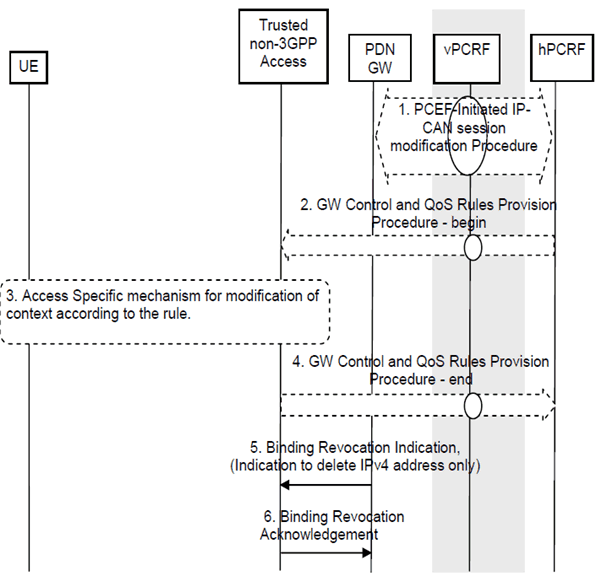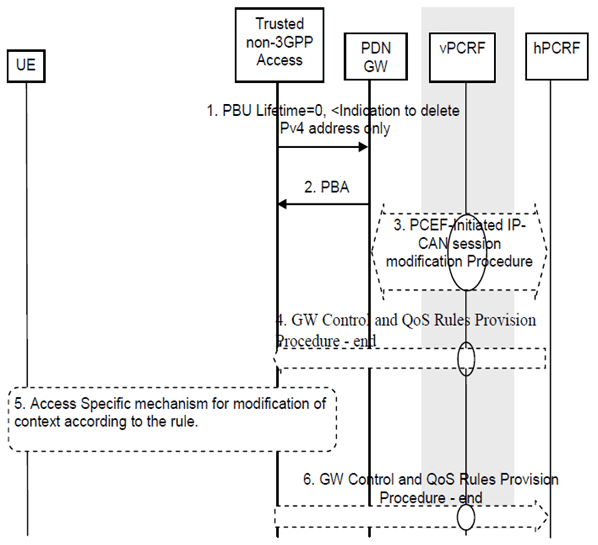Content for TS 23.402 Word version: 18.3.0
0…
4…
4.2…
4.2.2
4.2.3
4.3…
4.4…
4.5…
4.5.7…
4.6…
4.7…
4.7.2…
4.8…
4.8.2a…
4.9…
5…
5.2…
5.4…
5.5
5.6…
5.7…
5.8…
6…
6.2…
6.3
6.4…
6.4.3…
6.5…
6.6…
6.7…
6.8…
6.10…
6.13…
6.15…
7…
7.2…
7.3
7.4…
7.5…
7.6…
7.8…
7.10…
8…
8.2.1.2
8.2.1.3…
8.2.2
8.2.3…
8.2.6…
8.3…
8.4…
8.5…
9…
9.3…
9.4…
10…
13…
16…
16.1.2…
16.1.6…
16.2…
16.2.1a…
16.3…
16.4…
16.7…
16.8…
16.10…
17…
A…
C…
E…
6.13 PDN-GW initiated IPv4 address Delete Procedure
6.14 Non-3GPP access initiated IPv4 address Delete Procedure
...
...
6.13 PDN-GW initiated IPv4 address Delete Procedure p. 151
This procedure is initiated by the PDN-GW when the UE releases the IPv4 address using DHCPv4 procedure or the lease for the IP address has expired. The procedure is used to delete the IPv4 address from the PDN connection bearer context.

The optional interaction steps between the gateways and the PCRF in the procedures only occur if dynamic policy provisioning is deployed. Otherwise policy may be statically configured in the gateway.
The roaming (Figure 4.2.3-1), Local Breakout (Figure 4.2.3-4) and non-roaming (Figure 4.2.2-1) scenarios are depicted in the Figure. In the roaming case, the vPCRF acts as an intermediary, relaying the PCC messages between the hPCRF in the HPLMN to the BBERF/PCEF in the VPLMN. In the non-roaming case, the vPCRF is not involved at all. In the Roaming and LBO cases, the 3GPP AAA Proxy serves as an intermediary between the Trusted Non-3GPP IP Access and the 3GPP AAA Server in the HPLMN.
Step 1.
The PCEF initiates the IP-CAN Session Modification Procedure with the PCRF as specified in TS 23.203. The PDN-GW provides the information to enable the PCRF to uniquely identify the IP-CAN session.
Step 2.
In case QoS rules have to be modified, e.g. change of SDF filters, the PCRF initiates a GW Control and QoS rules provision procedure as described in TS 23.203 to inform the Trusted non-3GPP access of the updated QoS rules.
Step 3.
The Trusted non-3GPP Access initiates the "Network-initiated Dynamic PCC on S2a" procedure to release the bearers.
Step 4.
The trusted non-3GPP access informs the PCRF of the success of the QoS rules enforcement, thus ending the GW Control and QoS rules provision procedure described in TS 23.203.
Step 5.
The PDN-GW sends a Binding Revocation Indication (PDN address) message to the trusted non-3GPP access to revoke the IPv4 address.
Step 6.
The trusted non-3GPP access returns a Binding Revocation Acknowledgement message to the PDN-GW.
6.14 Non-3GPP access initiated IPv4 address Delete Procedure p. 152
This procedure is initiated by the Trusted non-3GPP access when the UE releases the IPv4 address using DHCPv4 procedure or the lease for the IP address has expired. The procedure is used to delete the IPv4 address from the PDN connection and bearer context.

Figure 6.14-1: Non-3GPP access initiated IPv4 address Delete Procedure
(⇒ copy of original 3GPP image)
(⇒ copy of original 3GPP image)
The optional interaction steps between the gateways and the PCRF in the procedures only occur if dynamic policy provisioning is deployed. Otherwise policy may be statically configured in the gateway.
The roaming (Figure 4.2.3-1), Local Breakout (Figure 4.2.3-4) and non-roaming (Figure 4.2.2-1) scenarios are depicted in the Figure. In the roaming case, the vPCRF acts as an intermediary, relaying the PCC messages between the hPCRF in the HPLMN to the BBERF/PCEF in the VPLMN. In the non-roaming case, the vPCRF is not involved at all. In the Roaming and LBO cases, the 3GPP AAA Proxy serves as an intermediary between the Trusted Non-3GPP IP Access and the 3GPP AAA Server in the HPLMN.
Step 1.
The MAG in the Trusted Non-3GPP IP Access sends a Proxy Binding Update (MN NAI, APN, lifetime=0, IPv4 only indication) message to the PDN-GW with lifetime value set to zero, indicating de-registration. The MN NAI identifies the UE to deregister from the PDN-GW. The indication for IPv4 only informs the UE that only the IPv4 address from BCE is to be deleted. The APN is needed in order to determine which PDN-GW to de-register the UE from, as some PDNs may support multiple PDNs.
Step 2.
The PDN-GW modifies the existing entry to delete the IPv4 address implied in the Proxy Binding Update message from its Binding Cache and releases all associated resources, and then sends a Proxy Binding Ack (MN NAI, APN, lifetime=0, IPv4 only indicator) message to the MAG in trusted non-3GPP access.
Step 3.
The PDN-GW initiates the PCEF initiated IP-CAN session modification procedure as described in TS 23.203 to inform the PCRF of the deleted IPv4 address. If PCC rules have changed the PCRF provides the updated PCC rules to the PDN-GW as part of this procedure.
Step 4.
In case QoS rules have to be modified, e.g. change of SDF filters, the PCRF initiates a GW Control and QoS rules provision procedure as described in TS 23.203 to inform the S-GW of the updated QoS rules.
Step 5.
An IP-CAN specific or resource release procedure may be triggered by the enforcement of the received policy rules.
Step 6.
The Trusted non-3GPP access informs the PCRF of the success of the QoS rules enforcement, thus ending the GW Control and QoS rules provision procedure described in TS 23.203.